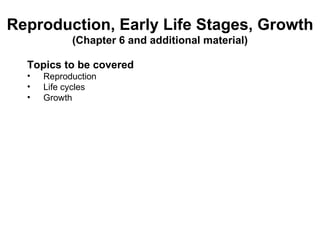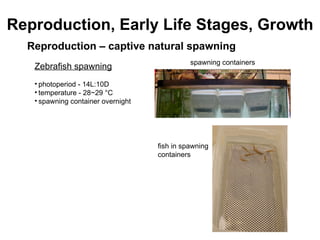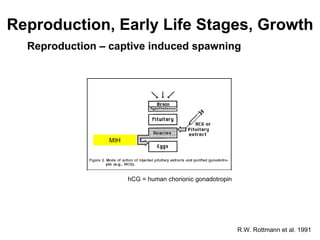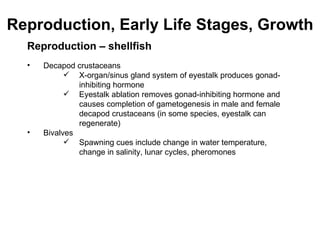Fish reproduction razia 2
- 1. Topics to be covered Reproduction Life cycles Growth Reproduction, Early Life Stages, Growth (Chapter 6 and additional material)
- 2. Reproduction ©C hormones of the reproductive system Brain-hypothalamic hormones (note error in textbook) Gonadotropin-releasing hormone (GnRH) Gonadotropin release-inhibitory factors (GnRIF; such as dopamine) Pituitary hormones: gonadotropins FSH: controls gonadal growth LH: controls gamete maturation and release Gonadal hormones (steroids) 11-ketotestosterone (androgen) 17 ? -estradiol (estrogen) Progesterone or its derivatives (progestins, they induce gamete maturation and ovulation; Maturation-Inducing Hormone = MIH) Reproduction, Early Life Stages, Growth
- 3. Reproduction ©C general environmental regulation Reproduction, Early Life Stages, Growth brain gonad Fish pituitary steroid hormones Environment seasonal photoperiod profile seasonal temperature profile food availability contaminants other liver LH FSH ? androgens ? estrogens Vg gonadal development ? progestins
- 4. Reproduction ©C hormones that control release of gametes Reproduction, Early Life Stages, Growth Brain Pit Gonad dopamine - LHRH + LH Gametes
- 5. Reproduction ©C captive spawning Captive spawning is preferred over collection of natural seed because, Greater control over timing of seed availability Greater control over number of available seeds Many of the current aquacultural species do not spawn naturally in captivity Often, problem is with the spawning of captive female, not male, fishes Methods for natural and hormonally induced spawning of captive fishes and other aquacultural organisms have been developed based on knowledge of their reproductive physiology Reproduction, Early Life Stages, Growth
- 6. Reproduction ©C captive natural spawning Reproduction, Early Life Stages, Growth Zebrafish spawning photoperiod - 14L:10D temperature - 28~29 ĪŃC spawning container overnight spawning containers fish in spawning containers
- 7. Reproduction ©C captive induced spawning Reproduction, Early Life Stages, Growth MIH MIH R.W. Rottmann et al. 1991 LHRH = GnRH
- 8. Reproduction ©C captive induced spawning Reproduction, Early Life Stages, Growth R.W. Rottmann et al. 1991 MIH hCG = human chorionic gonadotropin
- 9. Reproduction ©C shellfish Decapod crustaceans X-organ/sinus gland system of eyestalk produces gonad-inhibiting hormone Eyestalk ablation removes gonad-inhibiting hormone and causes completion of gametogenesis in male and female decapod crustaceans (in some species, eyestalk can regenerate) Bivalves Spawning cues include change in water temperature, change in salinity, lunar cycles, pheromones Reproduction, Early Life Stages, Growth
- 10. Reproduction, Early Life Stages, Growth Early life stages Fertilization leads to Zygote Depending on species, embryogenesis occurs over period of hours to weeks Following hatching, several stages of development can be described: Embryo-larval transition (endogenous feeding) Larval development Larva-juvenile transition (metamorphosis) Juvenile (prepubertal) growth Embryo-larva transition
- 11. Reproduction, Early Life Stages, Growth Early life stages Embryo development (endogenous nutrition) Days to weeks Need to clean egg mass following fertilization Use clean water for incubation (filtered water) Keep good levels of oxygen Appropriate temperature Embryo-larva transition (fishes ©C endogenous nutrition) Days to weeks Culture techniques similar to embryo Larval development Days to weeks Onset of exogenous feeding; providing appropriate food becomes major aspect of rearing (microalgae for molluscs and shrimps; rotifers and brine shrimp nauplii for fish and older shrimp larvae) Nitrogenous waste can become problem; need close monitoring of general water quality - rearing often occurs in large tanks to help with water quality Density of larvae reduced as they grow
- 12. Reproduction, Early Life Stages, Growth Early life stages (continued) Larval development is abbreviated or non-existent in some species (direct development) Embryos hatch already bearing juvenile form Larva-juvenile transition: metamorphosis Slight to marked changes in morphology, physiology and behavior, depending on species Juvenile development Postmetamorphic juvenile fishes are progressively weaned off live feeds on to artificial diets Initial culture is in hatchery tanks Grow out Final phase of culture when juveniles are grown until harvested
- 13. Reproduction, Early Life Stages, Growth Growth Bioenergetics Energy equations (note: specifics here are different from text but overall meaning is same) Simple equation: p x F = M + G p = proportion of food consumed that is assimilated F = amount of food consumed M = catabolism (energy release) G = growth (anabolism) Expanded equation: C = (Mr + Ma + SDA) + (F + U) + (Gs + Gr) C = rate of energy consumption Mr = standard metabolic rate (rate of energy use by a fasting animal at rest) Ma = metabolic rate increase (over standard) due to activity SDA = metabolic rate increase (over standard) due to digestion and assimilation of food F = waste due to egestion (feces) U = waste due to excretion (urine) Gs = somatic growth rate Gr = reproductive or gonadal growth rate
- 14. Reproduction, Early Life Stages, Growth Growth Patterns of growth of an organism can be described in several ways: Absolute growth: increase in size (length or weight), equal Y 2 -Y 1 Absolute growth rate: increase in size per unit time, equal (Y 2 -Y 1 )/( t 2 - t 1 ) Initially small, but as animal grows in size, there is increased capacity to take in and assimilate food Relative growth: increase in size relative to initial size, equal (Y 2 -Y 1 )/Y 1 Relative growth rate: increase in size per unit body size per unit time, equal (Y 2 -Y 1 )/[Y 1 ( t 2 - t 1 )] Initially rapid, but slows down with development Inflexion point
- 15. Reproduction, Early Life Stages, Growth Growth Measuring growth: Growth measurements are needed to monitor health and predict harvest time Measures Length : linear dimension using calipers or ruler - quick and easy Wet weight : most common assessment of whole body growth of fishes - quick and easy Dry weight : wet weight minus water (in oven at Ī▄100ĪŃC). Can usually be applied only on dead organism; it is most accurate method for assessing animal tissue growth, since changes in tissue water content may occur due to stress etc. Condition factor : weight/(length) 3 Ash-free dry weight : dry weight ©C inorganic ash (up to 24 h at 500ĪŃC). It is the dry weight of organic matter in the animal. Useful for animals with large inorganic components (e.g., bivalves) where it is relatively difficult to measure organic tissue content. Sometimes simply expressed as ash weight . Proximate composition : determination of different categories of compounds in tissues. Most commonly measured categories include carbohydrates, proteins, lipids.
- 16. Reproduction, Early Life Stages, Growth Growth Measuring growth in fishes: Length measurements Total length (TL): tip of snout to tip of longest caudal fin rays. Difficult to measure accurately if caudal fin is damaged Fork length (FL): tip of snout to fork (median caudal fin rays). Used in fishes with clear forks Standard length (SL): tip of snout to base of caudal fin (or tip of notochord in larval fish)
- 17. Notes on Chapter 6 reading material Subsections 6.3.1, 6.3.2, and 6.3.3, 6.4.2: general knowledge of topic covered in these subsections is necessary , but no need for details Formulas in subsection 6.4.1 are not required reading (you must instead know formulas covered in class) Under subsection 6.4.4, discussion of bivalves and decapod crustaceans is not required reading Table 6.2 is not required reading Reproduction, Early Life Stages, Growth














![Reproduction, Early Life Stages, Growth Growth Patterns of growth of an organism can be described in several ways: Absolute growth: increase in size (length or weight), equal Y 2 -Y 1 Absolute growth rate: increase in size per unit time, equal (Y 2 -Y 1 )/( t 2 - t 1 ) Initially small, but as animal grows in size, there is increased capacity to take in and assimilate food Relative growth: increase in size relative to initial size, equal (Y 2 -Y 1 )/Y 1 Relative growth rate: increase in size per unit body size per unit time, equal (Y 2 -Y 1 )/[Y 1 ( t 2 - t 1 )] Initially rapid, but slows down with development Inflexion point](https://image.slidesharecdn.com/fishreproductionrazia2-111204043708-phpapp01/85/Fish-reproduction-razia-2-14-320.jpg)


